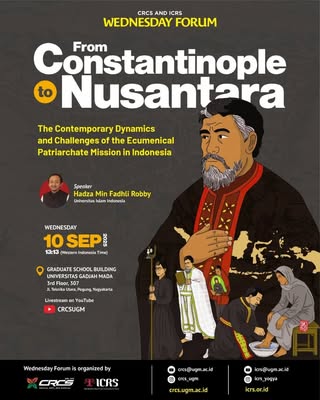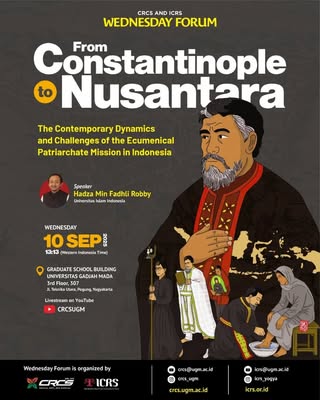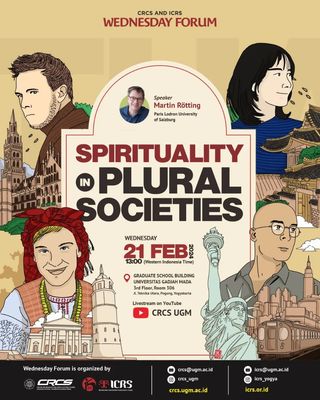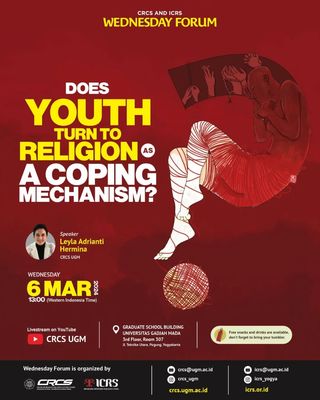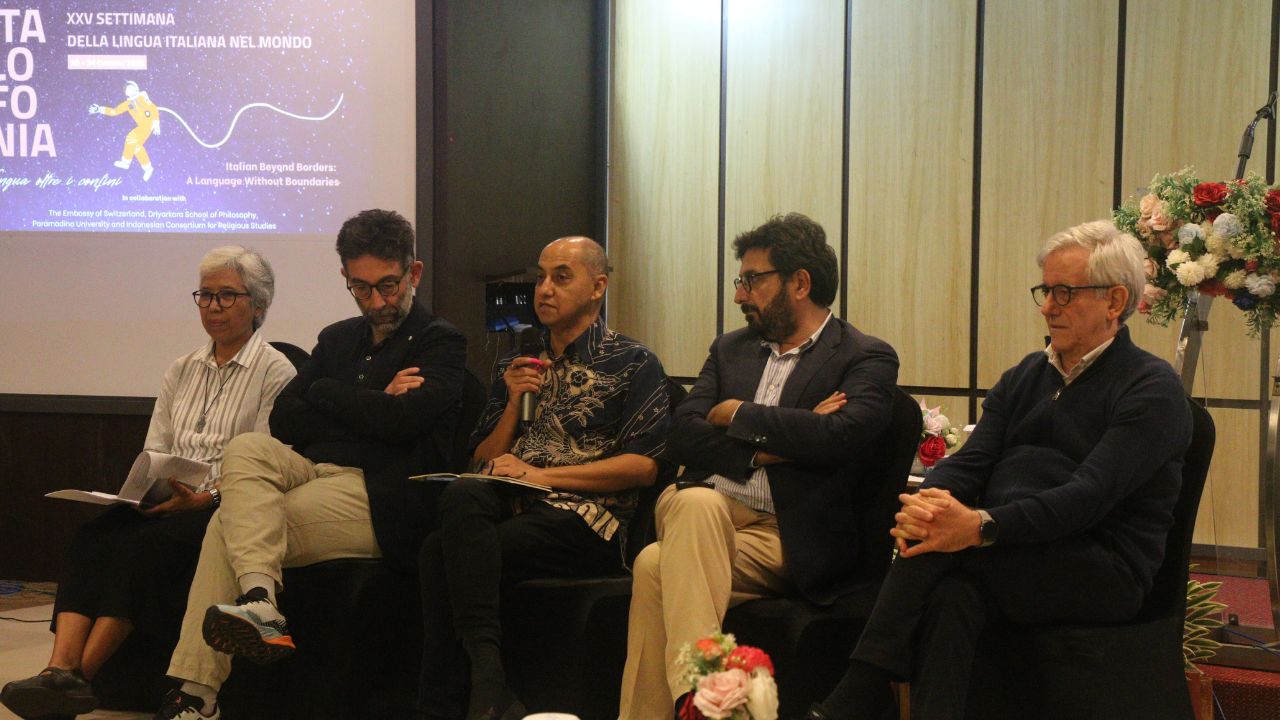
Fardan Mahmudatul Imamah
This essay asks if theology that envisions harmony between humans and nature is naïve, given a world that's growing hotter and drier. On one hand, religious narratives—especially those in the Franciscan tradition—revive a loving language toward creation. They refer to elements of nature as Brother Sun, Sister Moon, and Sister Earth. On the other hand, the world faces ongoing ecological crises, deforestation, and social inequality. These expose the fragility of our ecological spirituality. This contrast highlights the tension between spiritual ideals and harsh environmental realities.
When theology speaks of a "loving relationship" between humans and the natural world, does it not risk sounding like a romantic dream amid catastrophe? This question resonated throughout the seminar "Canticle of the Creatures – Language, Art, and Spirituality in the Franciscan Legacy," organized by the Indonesian Consortium for Religious Studies (ICRS) in collaboration with the Istituto Italiano di Cultura Jakarta and the Embassy of Italy, an interdisciplinary forum that brought together activists, theologians, artists, and researchers to reinterpret St. Francis of Assisi's message in the context of today's ecological crisis. Each speaker approached the question from a distinct angle, contributing to a rich and nuanced reflection.
Compassion Born of Suffering
Opening the discussion, Prof. Marco Bartoli, a medieval historian of spirituality from Libera Universita degli Studi Maria Ss. Assunta (LUMSA) University in Rome and a member of the International Society of Franciscan Studies in Assisi, invited participants to revisit the historical moment in which the Canticle of the Creatures was composed. For Bartoli, the hymn is not merely a beautiful poetic work but a spiritual document born out of suffering. St. Francis wrote this near the end of his life, when his body was weak and his eyesight nearly gone. It was in that darkness that he composed a radiant song of praise for the sun, water, and fire. This apparent contradiction – praising the goodness of creation amid personal pain – reveals how pain and limitation can foster an ecological vision grounded in compassion.
Bartoli's interpretation reveals that Franciscan spirituality is romantic but not naïve. It arises from wounds and suffering; by facing life's limits, Francis opened a connection with something greater. Francis's conversion, beginning with his meeting with lepers, sparked an understanding that love for creation cannot be separated from love for marginalized people. Bartoli sees this experience as the foundation of what Pope Francis later called integral ecology – a worldview that combines care for nature, social justice, and inner peace into one whole.
Justice Before Harmony
Dr. Zainal Abidin Bagir, Director of the Indonesian Consortium for Religious Studies (ICRS) and a long-time scholar of religion and ecology, points out that an overly romantic view of nature can hide harsh realities. The human–nature relationship often involves unequal power.
Reflecting on the exploitation of tropical forests in Indonesia, Bagir explains that both economic development and religious justification have frequently been used to excuse ecological destruction. According to Bagir, two mechanisms are at work. First, an aggressive model of economic development turns forests into mere resources for profit and growth. Second, a process of "religionization" leads dominant religions to stigmatize local spiritualities as animistic or idolatrous. In the name of progress (and under claims of orthodoxy), Indigenous reverence for nature is dismissed as superstition. Consequently, both the environment and the communities that depend on it are erased.
Bagir's critique challenges the comfort of a theology too eager to celebrate harmony. He argues that the idea of cosmic brotherhood with nature loses meaning if it is not grounded in social and political justice. For him, each act of deforestation signals not only ecological harm but also an injustice against the communities reliant on the forest. He calls on theologians – especially in Christian and Islamic traditions – to reconsider the habit of dismissing local faiths as "deviant." Instead, he advocates for a theology that acknowledges these traditions as genuine expressions of humanity's spiritual bond with nature and the Divine.
When the Sacred Became Visible
While Bartoli drew on historical sources, Costantino D'Orazio, an art curator and Director of the National Museums of Umbria, invited participants to explore how the Franciscan spirit took form in visual art. He traced the evolution of Christian art from Byzantine symbolism to Giotto's human-centered realism, showing how Franciscan spirituality inspired a new perspective—one that finds the presence of God in the beauty of the physical world.
D'Orazio noted that after the 13th century, nature began to appear in paintings not just as a backdrop, but as a companion to humanity. Hills, trees, and rivers were depicted with individuality. Giotto's image of St. Francis preaching to the birds marked a significant change in religious aesthetics, portraying nature not as an object but as a partner in dialogue. In this way, what might be called romanticism in art was more than mere sentimentality; it represented a shift in how people understood the world as alive and valuable in itself.
The Spirituality of the Soil
The question of how to "see" nature and translate that vision into practice was explored by Sr. Fransisca Yohana Sri Winarsih, FCJ, a researcher and doctoral candidate at ICRS. Her ethnographic work focuses on interfaith organic farming communities in Central Java and Yogyakarta. She described these farmers as practitioners of an ecological spirituality without formal theory. They may never have read the Canticle of the Creatures, yet they embody its spirit in daily life.
These farmers reject synthetic fertilizers, avoid calling insects "pests," and share part of their harvest with other creatures. They call the land Ibu Pertiwi (Mother Earth) and see themselves as part of her living body. To them, human life is connected to the health of the soil. One farmer summed up this belief by saying that whatever happens to oneself also happens to the earth. In that simple truth lies the essence of ecological theology: humans are not masters of nature but beings shaped and nourished by it.
Yohana emphasized that love for the Earth always demands sacrifice. In a modern economy obsessed with profit, these farmers consciously reject the usual logic of gain. They work harder, make their own fertilizer, and are sometimes ridiculed by neighbors for their traditional methods. However, within such a struggle lies a kind of spiritual freedom – a fidelity to the Earth that needs no recognition. For Yohana, this is not naive romanticism but an ethical practice of love: a way of becoming human through patience, process, and coexistence with all living beings.
Pilgrimage as Ecological Practice
While Yohana spoke of the cultivated earth, Gianluigi Bettin, an Italian writer and social activist long engaged with environmental movements and Franciscan spirituality, turned attention to the planet as a space of journey. In his reflection on La Via di Francesco – a 500-kilometer pilgrimage route from Rimini to Assisi – he interpreted pilgrimage as another form of ecological spirituality.
Walking, Bettin explained, is not merely a physical act but a moral one. Modern pilgrims do not simply seek holy sites; they learn to align themselves with the Earth's rhythm. In an accelerated world, slowing down to walk becomes a form of resistance. The journey teaches patience, silence, and weariness – three experiences through which we rediscover our bodies and our bond with the land.
Bettin rejected the idea of pilgrimage as sterile spiritual tourism. He stressed the importance of slow tourism that connects cities and villages, history and environment, people and local communities. Along this route, pilgrims encounter not only beauty but also the ecological wounds of modernity – polluted rivers, eroded forests, and depopulated villages. In this sense, pilgrimage is not an escape from the world but a new way of inhabiting it. Nature becomes not just an object of contemplation but an ethical space where humanity learns to slow down and listen again.
Romanticism as Moral Resistance
The convergence of ideas from Bartoli, Bagir, D'Orazio, Yohana, and Bettin reveals a theology negotiating between beauty and reality. A theology that romanticizes nature may seem gentle, even sentimental, yet within that gentleness lies a subtle critique of the systemic violence of the modern world.
If by romanticism we mean the naïve belief that humans and nature live in harmony, then yes – it is naive. Nature has become an arena of power struggles, from mining concessions to economic development projects that displace Indigenous communities. Such romanticism soothes the conscience without challenging injustice.
However, if romanticism is understood as a way of preserving moral sensitivity to life, then it remains profoundly relevant. It restores a sense of awe and empathy lost amid capitalist and technocratic logic. It refuses to see nature as a machine, affirming instead that our relationship with the Earth is ethical—demanding humility and responsibility.
Franciscan romanticism, as these speakers demonstrate, is not an escape from reality but a form of resistance to modern alienation. It refuses to treat the world merely as an object of study or economic resource. In the language of St. Francis, nature is "brother and sister" – not because it is biologically equal, but because all beings share in the Creator's love.
In this sense, romanticism is not an intellectual weakness but a moral strategy against cynicism. It teaches that to care for the Earth, one must first learn to love it. Moreover, love, as we know, often appears naïve to a world grown cold. In an age that normalizes ecological destruction, perhaps the most radical act is the courage to keep loving – even when that love appears naive.





